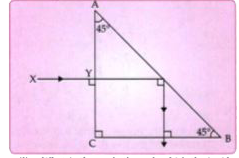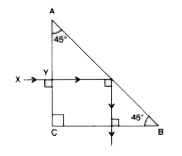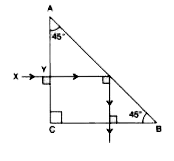A ray of light XY passes through a right angled isosceles prisms as shown below.i What is the angle through which the incident ray deviates and emerges out of the prism? ii Name the instrument where this action of prism is put into use. iii Which prism surface will behave as a mirror?
i The angle of deviation between incident and emerging out ray from prism is S = 90°ii This action of prism is used perfect reflector the instrument called the instrument called periscope.iii The Prism Surface AB act is mirror.
Related Solutions
A ray of light XY passes through a right angled isosceles prism as shown alongside Figure. (a) What is the angle through which the incident ray deviates and emerges out of the prism? 9b) Name the instrument where this action of prism is put into use. (c) Which prism surface will behave as a mirror ?
View SolutionA ray of light XY passes through a right angled isosceles prism as shown below:

Which prism surface will behave as a mirror ?
View SolutionA ray of light XY passes through a right angled isosceles prism as shown alongside.
Which prism surface will behave as a mirror ?

View SolutionA ray of light XY passes through a right angled isosceles prism as shown below.
Name the instrument where this action of prism is put into use.
View SolutionA ray of light XY passes through a right angled isosceles prism as shown alongside. Name the instrument where this action of prism is put into use.
View SolutionA ray of light XY passes through a right angled isosceles prism as shown alongside.
What is the angle through which the incident ray deviates and emerges out of the prism ?

View SolutionA ray of light XY passes through a right angled isosceles prism as shown below. What is the angle through which the incident ray deviates and emerges out of the prism?
View SolutionA ray of light is incident on one face of a prism at an angle of 50^(@) with the normal . The ray is deviated by the prism through 42^(@) . What is the angle of the prism , if the angle of emergence is 51^(@) ?
View SolutionThe angle of incidence for a ray of light at a refracting surface of a prism is . The angle of prism is . If the ray suffers minimum deviation through the prism, then the angle of minimum deviation is:
View SolutionA prism has a prism angle 60^(@) . A light ray incident at an angle of 45^(@) deviates by an angle 40^(@) . Calculate the angle between emergent ray and prism surface.
View SolutionA ray of light PQ is incident normally on the hypotenuse of a right angled prism ABC as shown in the diagram. Name an instrument where this action of the prism is used.
View SolutionA ray of light PQ is incident normally on the hypotenuse of a right angled prism ABC as shown in the diagram given below: Name an instrument where this action of the prism is used.
View SolutionA ray of light passes through the equilateral prism such that angle of incidence is equal to the angle of emergence if the angle of incidence is 45^(@) . The angle of deviation will be
View SolutionA ray of light passes through the equilateral prism such that angle of incidence is equal to the angle of emergence if the angle of incidence is . The angle of deviation will be
View SolutionThe angle of incidence for a ray of light at a refracting surface of a prism is 45^(@) . The angle of prism is 60^(@) . If the ray surface minimum deviation through the prism, the angle of minimum deviation and refractive index of the material of the prism respectively, are:
View SolutionA ray of light is incident at an angle of on the face of a prism having refracting angle The ray emerging out of the prism makes an angle with the incident ray. Show that the emergent ray is perpendicular to the face through which it emerges.
View SolutionA ray of light is incident at an angle of on the face of a prism having refracting angle The ray emerging out of the prism makes an angle with the incident ray. Show that the emergent ray is perpendicular to the face through which it emerges.
View SolutionA ray of light is incident at an angle of 60^@ on the face of a prism having refracting angle 30^@. The ray emerging out of the prism makes an angle 30^@ with the incident ray. Show that the emergent ray is perpendicular to the face through which it emerges.
View SolutionA ray of light passes through an equilateral prism such that an angle of incidence is equal to the angle of emergence and the latter is equal to (3)/(4) th the angle of prism. The angle of deviation is :
View SolutionWrite a relation between the angle of incidence (i), angle of emergence (e), angle of prism (A) and angle of deviation (d) for a ray of light passing through an equilateral prism.
View Solution